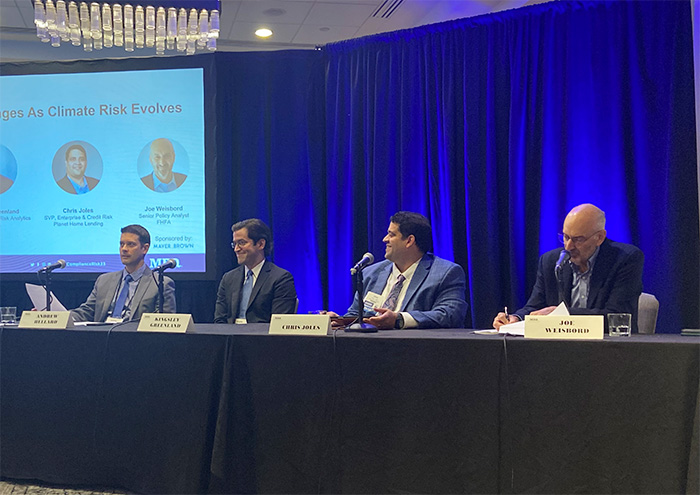
Natural Disasters, Insurance Landscape Cause Industry Disruptions, Panelists Say

(From left: Hellard, Greenland, Joles and Weisbord. Picture by Anneliese Mahoney)
WASHINGTON–Amid a cascading series of natural disasters, the homeowners’ insurance market has been seriously disrupted, and is likely to remain that way for the foreseeable future, panelists said at the Mortgage Bankers Association’s Compliance and Risk Management conference.
Speaking at a Sept. 11 session titled, “Insurance Challenges as Climate Risk Evolves,” moderator Andrew Hellard, Vice President of Product Development for Matic Insurance, gave a lay of the land.
“2022 was the most expensive year on record for insurers with $50 billion in losses recorded from Hurricane Ian alone. Unfortunately those losses have continued in 2023,” Hellard said.
Kingsley Greenland, Director of Mortgage Risk Analytics for Verisk, highlighted some of the recent climate-related issues, including rising temperatures, hurricanes (including the recent unexpected occurrence in Southern California), wildfires, earthquakes and flood.
However, Greenland said, it’s not just about different climate events at this point. “Yet close to maybe 50% of that is a function of the built environment increasing, right in harm’s way,” Greenland said, noting that people do like to live in areas with increased risk, such as Florida. Also of note is increasing urban and wildlife overlap.
These factors are causing notable disruptions in the market, in a number of different ways.
For example, Hellard said his firm is seeing an increasing number of business restrictions from insurance carriers, and a decrease in the number of policies that are available.
Hellard said, per a Matic Insurance survey of lenders, 79% reported securing home insurance has become more of a problem this year compared with other time periods.
“This is a time when affordability is under tremendous stress and pressure due to the interest rate environment, due to the home price and structural supply and inventory issues that we’re facing. So now we’re adding insurance costs on top of that. It’s creating an almost impossible situation, certainly for first-time buyers, and for low-to-moderate income buyers, who are a critical part of the market,” noted Joe Weisbord, Senior Policy Analyst with the Federal Housing Finance Agency.
Chris Joles, Senior Vice President, Enterprise and Credit Risk for Planet Home Lending, noted he saw a spike in modifications in Florida in the third and fourth quarters of 2022 and a spike in California earlier this year.
Weisbord listed some other disruptions, including insurance rating downgrades. “We saw this last year in Florida–although I should be careful to caveat that a lot of what happened in Florida was not climate-related per se–but it gives you a sense of potential market disruption,” Weisbord said. “Demotech downgraded three providers and I think they put a dozen or so additional on notice.”
In general, a patchwork approach from state-to-state on the regulatory front continues to be an extremely pressing issue, the panelists said, among myriad other challenges and factors.
So, what’s next?
One thing Weisbord emphasized is that “it’s incredibly important that a regulatory framework emerges, that’s understandable and that’s operational for the industry,” noting FHFA’s ongoing efforts on that front, along with other entities.
“Catastrophe modeling is ultimately what you should do to understand natural hazard risk to your portfolio,” Greenland said, as advice to some in the industry.
There’s also the matter of education and awareness among homebuyers and home owners.
“Both Fannie and Freddie have done research on this, and conducted some surveys and found that the level of awareness and understanding of the risks is quite low among consumers,” Weisbord said. “And that’s an area we’re very focused on.”
Weisbord highlighted the importance of voluntary resiliency programs, which involve various building practices and other features designed to better stand up to climate risks. He also noted that there needs to be development of better disclosures built on more comprehensive data.
“This is not permanent. The insurance industry is full of very smart people who are very good at math. In jurisdictions where prices are allowed to adapt, they will,” Hellard said. “There will be definitely hotspots that remain a problem. California will be an issue. Florida will still be an issue. The Gulf Coast will be questionable, but over time, I think prices will adapt, capacity will come back, but I can’t tell you when.”
